Developing a Human Resource Development Plan for Woolsworth: Analysis
VerifiedAdded on 2022/10/17
|21
|4226
|13
Report
AI Summary
This report provides a comprehensive HRD plan for Woolsworth, a major Australian supermarket chain, focusing on need analysis to enhance employee performance and career development. It details the importance of HRD in gaining a competitive advantage, especially in a duopoly market. The report outlines the objectives of the HRD plan, including improving employee competency, efficiency, and addressing performance management issues. It includes a detailed need analysis design with steps, resource requirements, and cost considerations for various training programs. A program schedule with activities for employee development and a career growth cycle are also presented. The report further explores performance management models, including goal-setting and expectancy theories, and provides a participant assessment framework. Finally, it outlines the responsibilities of the HRD plan and concludes with recommendations for Woolsworth to improve its human resource practices for better productivity and profitability.
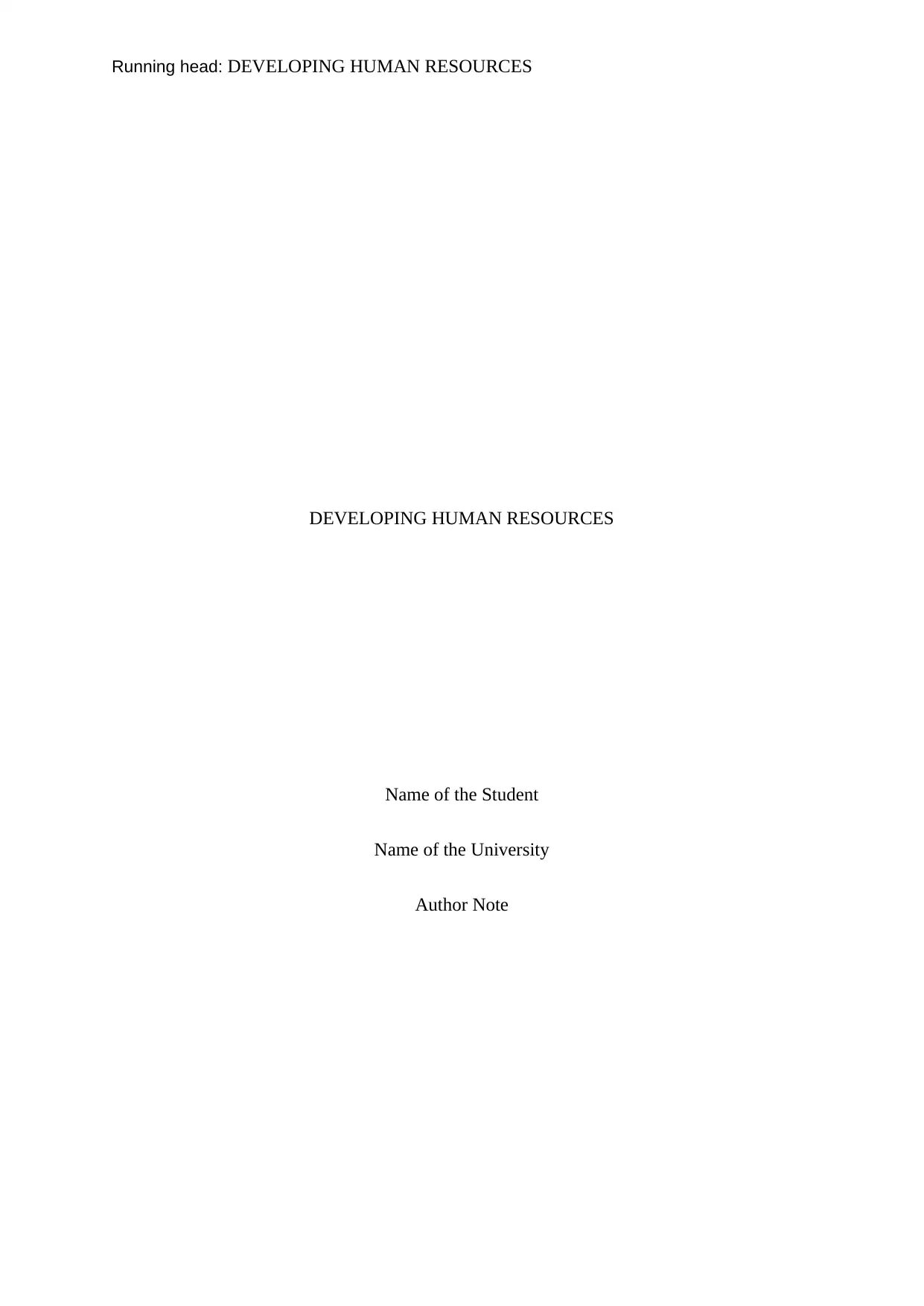
Running head: DEVELOPING HUMAN RESOURCES
DEVELOPING HUMAN RESOURCES
Name of the Student
Name of the University
Author Note
DEVELOPING HUMAN RESOURCES
Name of the Student
Name of the University
Author Note
Paraphrase This Document
Need a fresh take? Get an instant paraphrase of this document with our AI Paraphraser
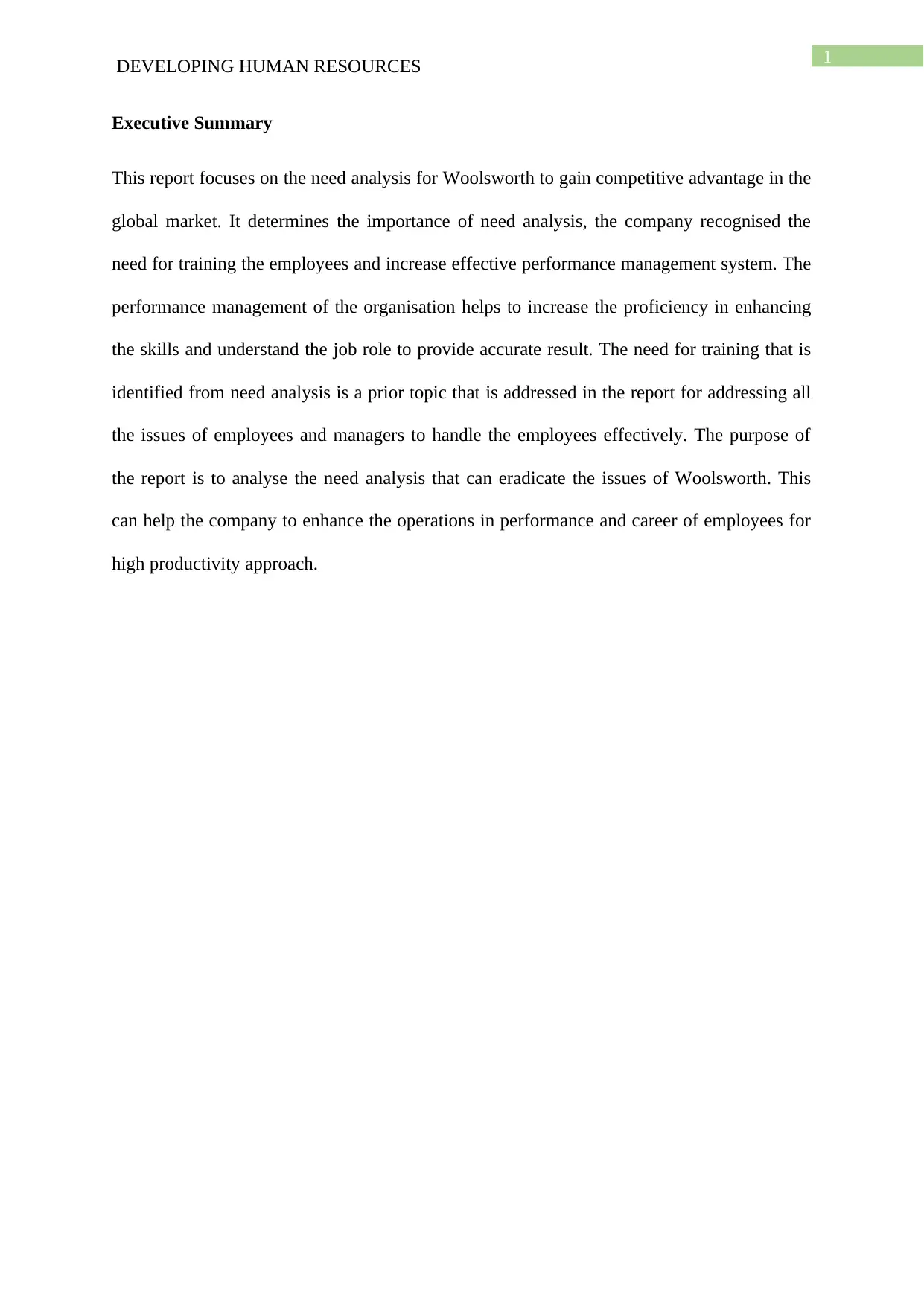
1
DEVELOPING HUMAN RESOURCES
Executive Summary
This report focuses on the need analysis for Woolsworth to gain competitive advantage in the
global market. It determines the importance of need analysis, the company recognised the
need for training the employees and increase effective performance management system. The
performance management of the organisation helps to increase the proficiency in enhancing
the skills and understand the job role to provide accurate result. The need for training that is
identified from need analysis is a prior topic that is addressed in the report for addressing all
the issues of employees and managers to handle the employees effectively. The purpose of
the report is to analyse the need analysis that can eradicate the issues of Woolsworth. This
can help the company to enhance the operations in performance and career of employees for
high productivity approach.
DEVELOPING HUMAN RESOURCES
Executive Summary
This report focuses on the need analysis for Woolsworth to gain competitive advantage in the
global market. It determines the importance of need analysis, the company recognised the
need for training the employees and increase effective performance management system. The
performance management of the organisation helps to increase the proficiency in enhancing
the skills and understand the job role to provide accurate result. The need for training that is
identified from need analysis is a prior topic that is addressed in the report for addressing all
the issues of employees and managers to handle the employees effectively. The purpose of
the report is to analyse the need analysis that can eradicate the issues of Woolsworth. This
can help the company to enhance the operations in performance and career of employees for
high productivity approach.
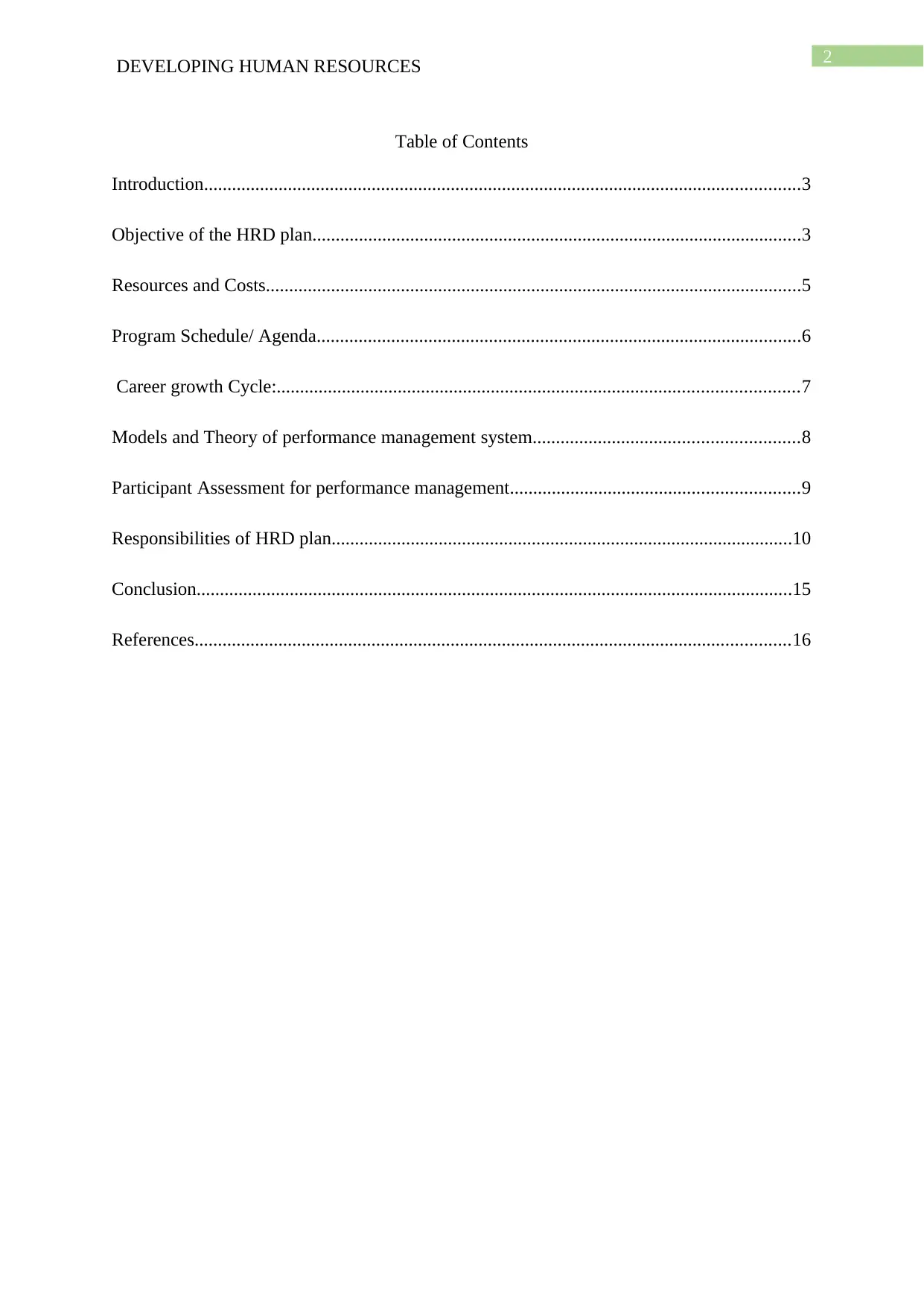
2
DEVELOPING HUMAN RESOURCES
Table of Contents
Introduction................................................................................................................................3
Objective of the HRD plan.........................................................................................................3
Resources and Costs...................................................................................................................5
Program Schedule/ Agenda........................................................................................................6
Career growth Cycle:................................................................................................................7
Models and Theory of performance management system.........................................................8
Participant Assessment for performance management..............................................................9
Responsibilities of HRD plan...................................................................................................10
Conclusion................................................................................................................................15
References................................................................................................................................16
DEVELOPING HUMAN RESOURCES
Table of Contents
Introduction................................................................................................................................3
Objective of the HRD plan.........................................................................................................3
Resources and Costs...................................................................................................................5
Program Schedule/ Agenda........................................................................................................6
Career growth Cycle:................................................................................................................7
Models and Theory of performance management system.........................................................8
Participant Assessment for performance management..............................................................9
Responsibilities of HRD plan...................................................................................................10
Conclusion................................................................................................................................15
References................................................................................................................................16
⊘ This is a preview!⊘
Do you want full access?
Subscribe today to unlock all pages.

Trusted by 1+ million students worldwide

3
DEVELOPING HUMAN RESOURCES
DEVELOPING HUMAN RESOURCES
Paraphrase This Document
Need a fresh take? Get an instant paraphrase of this document with our AI Paraphraser
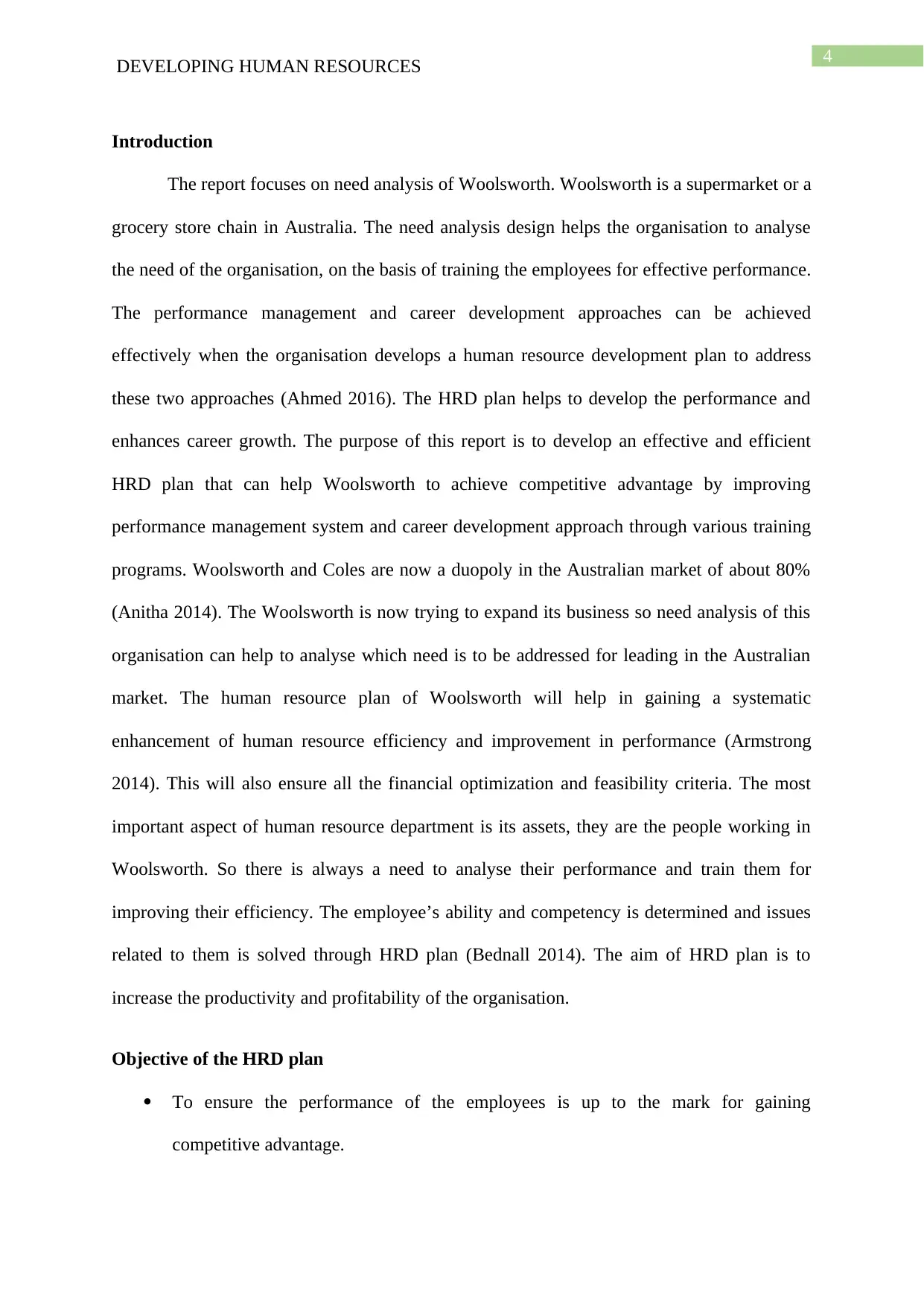
4
DEVELOPING HUMAN RESOURCES
Introduction
The report focuses on need analysis of Woolsworth. Woolsworth is a supermarket or a
grocery store chain in Australia. The need analysis design helps the organisation to analyse
the need of the organisation, on the basis of training the employees for effective performance.
The performance management and career development approaches can be achieved
effectively when the organisation develops a human resource development plan to address
these two approaches (Ahmed 2016). The HRD plan helps to develop the performance and
enhances career growth. The purpose of this report is to develop an effective and efficient
HRD plan that can help Woolsworth to achieve competitive advantage by improving
performance management system and career development approach through various training
programs. Woolsworth and Coles are now a duopoly in the Australian market of about 80%
(Anitha 2014). The Woolsworth is now trying to expand its business so need analysis of this
organisation can help to analyse which need is to be addressed for leading in the Australian
market. The human resource plan of Woolsworth will help in gaining a systematic
enhancement of human resource efficiency and improvement in performance (Armstrong
2014). This will also ensure all the financial optimization and feasibility criteria. The most
important aspect of human resource department is its assets, they are the people working in
Woolsworth. So there is always a need to analyse their performance and train them for
improving their efficiency. The employee’s ability and competency is determined and issues
related to them is solved through HRD plan (Bednall 2014). The aim of HRD plan is to
increase the productivity and profitability of the organisation.
Objective of the HRD plan
To ensure the performance of the employees is up to the mark for gaining
competitive advantage.
DEVELOPING HUMAN RESOURCES
Introduction
The report focuses on need analysis of Woolsworth. Woolsworth is a supermarket or a
grocery store chain in Australia. The need analysis design helps the organisation to analyse
the need of the organisation, on the basis of training the employees for effective performance.
The performance management and career development approaches can be achieved
effectively when the organisation develops a human resource development plan to address
these two approaches (Ahmed 2016). The HRD plan helps to develop the performance and
enhances career growth. The purpose of this report is to develop an effective and efficient
HRD plan that can help Woolsworth to achieve competitive advantage by improving
performance management system and career development approach through various training
programs. Woolsworth and Coles are now a duopoly in the Australian market of about 80%
(Anitha 2014). The Woolsworth is now trying to expand its business so need analysis of this
organisation can help to analyse which need is to be addressed for leading in the Australian
market. The human resource plan of Woolsworth will help in gaining a systematic
enhancement of human resource efficiency and improvement in performance (Armstrong
2014). This will also ensure all the financial optimization and feasibility criteria. The most
important aspect of human resource department is its assets, they are the people working in
Woolsworth. So there is always a need to analyse their performance and train them for
improving their efficiency. The employee’s ability and competency is determined and issues
related to them is solved through HRD plan (Bednall 2014). The aim of HRD plan is to
increase the productivity and profitability of the organisation.
Objective of the HRD plan
To ensure the performance of the employees is up to the mark for gaining
competitive advantage.
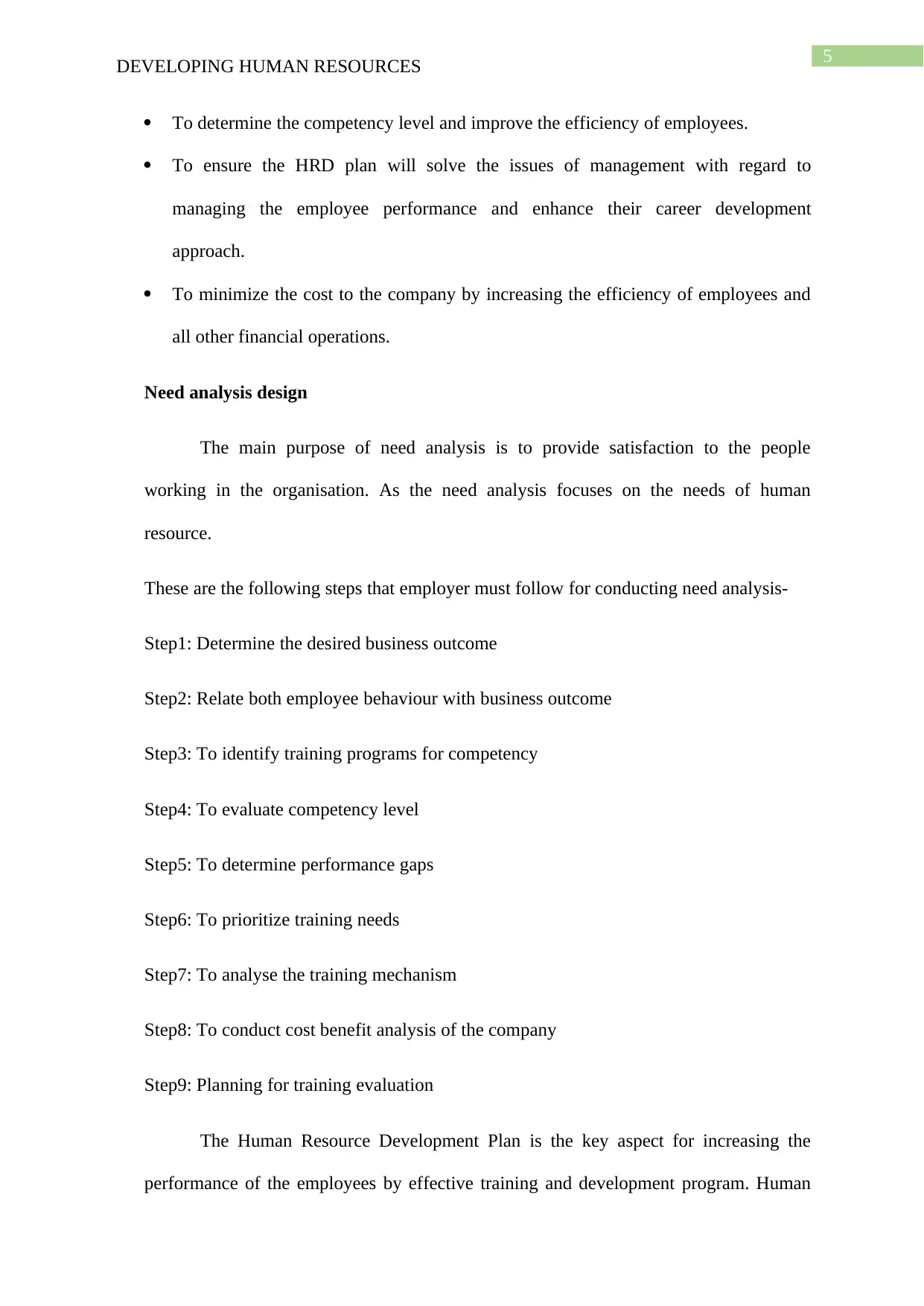
5
DEVELOPING HUMAN RESOURCES
To determine the competency level and improve the efficiency of employees.
To ensure the HRD plan will solve the issues of management with regard to
managing the employee performance and enhance their career development
approach.
To minimize the cost to the company by increasing the efficiency of employees and
all other financial operations.
Need analysis design
The main purpose of need analysis is to provide satisfaction to the people
working in the organisation. As the need analysis focuses on the needs of human
resource.
These are the following steps that employer must follow for conducting need analysis-
Step1: Determine the desired business outcome
Step2: Relate both employee behaviour with business outcome
Step3: To identify training programs for competency
Step4: To evaluate competency level
Step5: To determine performance gaps
Step6: To prioritize training needs
Step7: To analyse the training mechanism
Step8: To conduct cost benefit analysis of the company
Step9: Planning for training evaluation
The Human Resource Development Plan is the key aspect for increasing the
performance of the employees by effective training and development program. Human
DEVELOPING HUMAN RESOURCES
To determine the competency level and improve the efficiency of employees.
To ensure the HRD plan will solve the issues of management with regard to
managing the employee performance and enhance their career development
approach.
To minimize the cost to the company by increasing the efficiency of employees and
all other financial operations.
Need analysis design
The main purpose of need analysis is to provide satisfaction to the people
working in the organisation. As the need analysis focuses on the needs of human
resource.
These are the following steps that employer must follow for conducting need analysis-
Step1: Determine the desired business outcome
Step2: Relate both employee behaviour with business outcome
Step3: To identify training programs for competency
Step4: To evaluate competency level
Step5: To determine performance gaps
Step6: To prioritize training needs
Step7: To analyse the training mechanism
Step8: To conduct cost benefit analysis of the company
Step9: Planning for training evaluation
The Human Resource Development Plan is the key aspect for increasing the
performance of the employees by effective training and development program. Human
⊘ This is a preview!⊘
Do you want full access?
Subscribe today to unlock all pages.

Trusted by 1+ million students worldwide
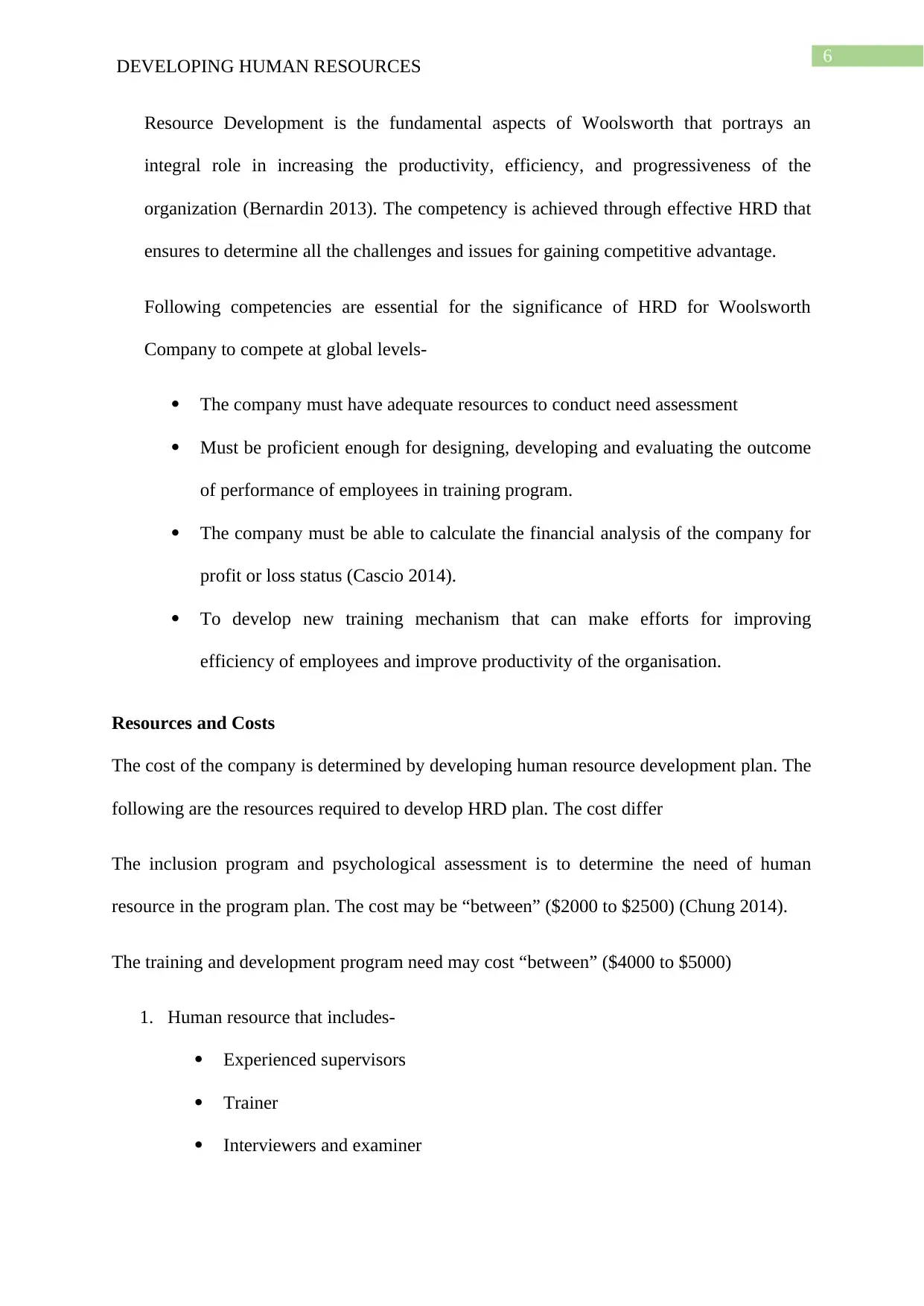
6
DEVELOPING HUMAN RESOURCES
Resource Development is the fundamental aspects of Woolsworth that portrays an
integral role in increasing the productivity, efficiency, and progressiveness of the
organization (Bernardin 2013). The competency is achieved through effective HRD that
ensures to determine all the challenges and issues for gaining competitive advantage.
Following competencies are essential for the significance of HRD for Woolsworth
Company to compete at global levels-
The company must have adequate resources to conduct need assessment
Must be proficient enough for designing, developing and evaluating the outcome
of performance of employees in training program.
The company must be able to calculate the financial analysis of the company for
profit or loss status (Cascio 2014).
To develop new training mechanism that can make efforts for improving
efficiency of employees and improve productivity of the organisation.
Resources and Costs
The cost of the company is determined by developing human resource development plan. The
following are the resources required to develop HRD plan. The cost differ
The inclusion program and psychological assessment is to determine the need of human
resource in the program plan. The cost may be “between” ($2000 to $2500) (Chung 2014).
The training and development program need may cost “between” ($4000 to $5000)
1. Human resource that includes-
Experienced supervisors
Trainer
Interviewers and examiner
DEVELOPING HUMAN RESOURCES
Resource Development is the fundamental aspects of Woolsworth that portrays an
integral role in increasing the productivity, efficiency, and progressiveness of the
organization (Bernardin 2013). The competency is achieved through effective HRD that
ensures to determine all the challenges and issues for gaining competitive advantage.
Following competencies are essential for the significance of HRD for Woolsworth
Company to compete at global levels-
The company must have adequate resources to conduct need assessment
Must be proficient enough for designing, developing and evaluating the outcome
of performance of employees in training program.
The company must be able to calculate the financial analysis of the company for
profit or loss status (Cascio 2014).
To develop new training mechanism that can make efforts for improving
efficiency of employees and improve productivity of the organisation.
Resources and Costs
The cost of the company is determined by developing human resource development plan. The
following are the resources required to develop HRD plan. The cost differ
The inclusion program and psychological assessment is to determine the need of human
resource in the program plan. The cost may be “between” ($2000 to $2500) (Chung 2014).
The training and development program need may cost “between” ($4000 to $5000)
1. Human resource that includes-
Experienced supervisors
Trainer
Interviewers and examiner
Paraphrase This Document
Need a fresh take? Get an instant paraphrase of this document with our AI Paraphraser
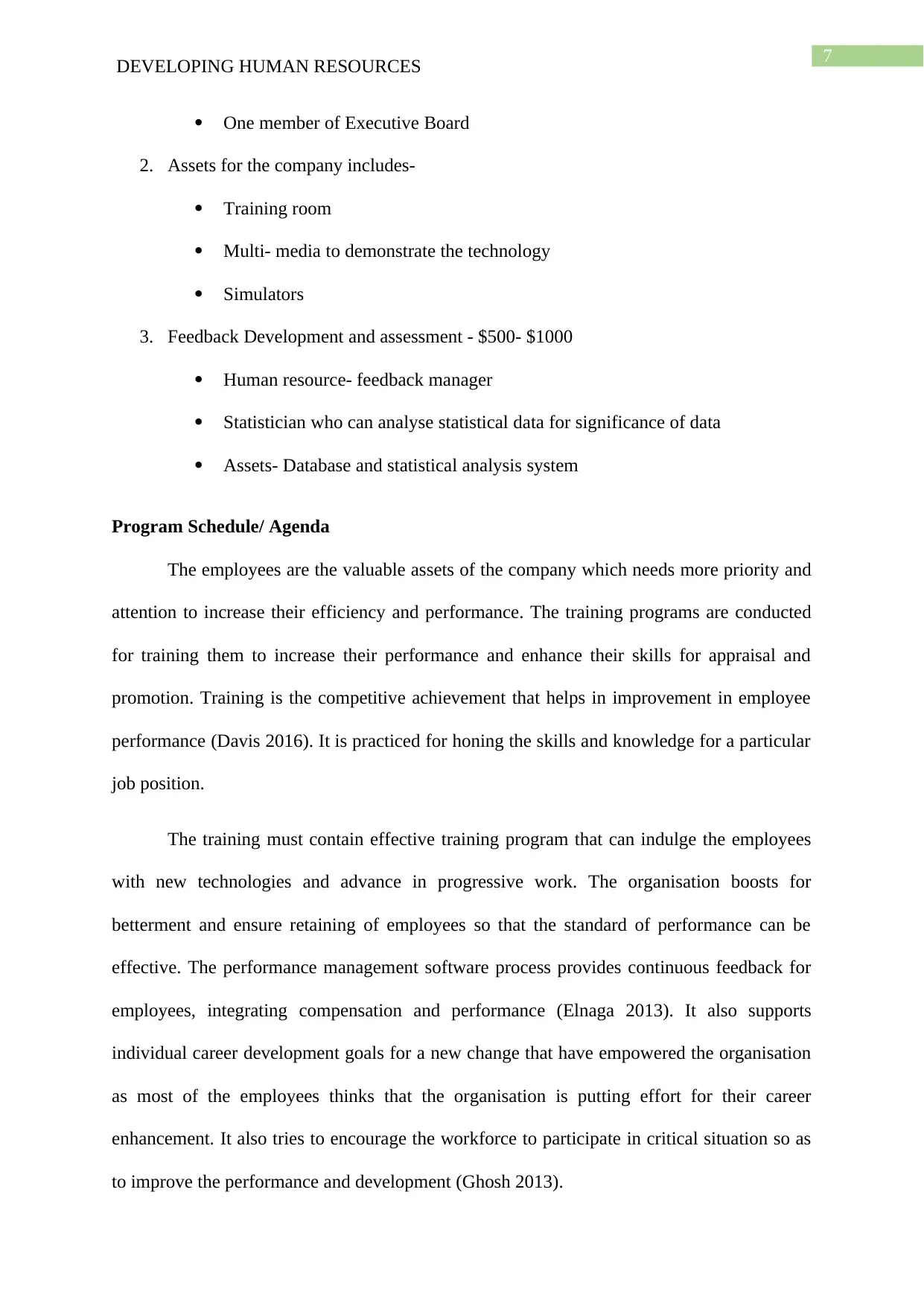
7
DEVELOPING HUMAN RESOURCES
One member of Executive Board
2. Assets for the company includes-
Training room
Multi- media to demonstrate the technology
Simulators
3. Feedback Development and assessment - $500- $1000
Human resource- feedback manager
Statistician who can analyse statistical data for significance of data
Assets- Database and statistical analysis system
Program Schedule/ Agenda
The employees are the valuable assets of the company which needs more priority and
attention to increase their efficiency and performance. The training programs are conducted
for training them to increase their performance and enhance their skills for appraisal and
promotion. Training is the competitive achievement that helps in improvement in employee
performance (Davis 2016). It is practiced for honing the skills and knowledge for a particular
job position.
The training must contain effective training program that can indulge the employees
with new technologies and advance in progressive work. The organisation boosts for
betterment and ensure retaining of employees so that the standard of performance can be
effective. The performance management software process provides continuous feedback for
employees, integrating compensation and performance (Elnaga 2013). It also supports
individual career development goals for a new change that have empowered the organisation
as most of the employees thinks that the organisation is putting effort for their career
enhancement. It also tries to encourage the workforce to participate in critical situation so as
to improve the performance and development (Ghosh 2013).
DEVELOPING HUMAN RESOURCES
One member of Executive Board
2. Assets for the company includes-
Training room
Multi- media to demonstrate the technology
Simulators
3. Feedback Development and assessment - $500- $1000
Human resource- feedback manager
Statistician who can analyse statistical data for significance of data
Assets- Database and statistical analysis system
Program Schedule/ Agenda
The employees are the valuable assets of the company which needs more priority and
attention to increase their efficiency and performance. The training programs are conducted
for training them to increase their performance and enhance their skills for appraisal and
promotion. Training is the competitive achievement that helps in improvement in employee
performance (Davis 2016). It is practiced for honing the skills and knowledge for a particular
job position.
The training must contain effective training program that can indulge the employees
with new technologies and advance in progressive work. The organisation boosts for
betterment and ensure retaining of employees so that the standard of performance can be
effective. The performance management software process provides continuous feedback for
employees, integrating compensation and performance (Elnaga 2013). It also supports
individual career development goals for a new change that have empowered the organisation
as most of the employees thinks that the organisation is putting effort for their career
enhancement. It also tries to encourage the workforce to participate in critical situation so as
to improve the performance and development (Ghosh 2013).

8
DEVELOPING HUMAN RESOURCES
DEVELOPING HUMAN RESOURCES
⊘ This is a preview!⊘
Do you want full access?
Subscribe today to unlock all pages.

Trusted by 1+ million students worldwide
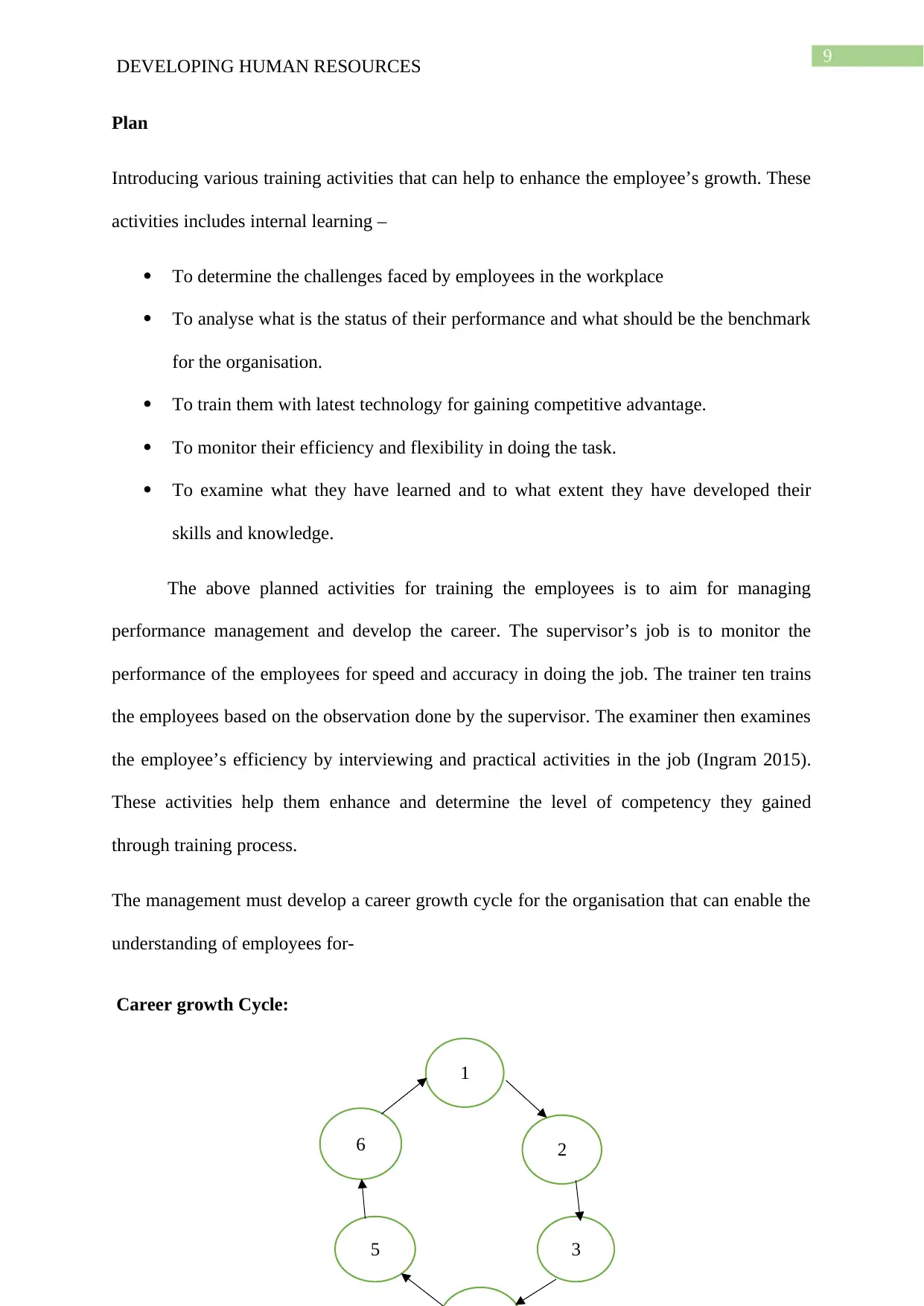
9
DEVELOPING HUMAN RESOURCES
Plan
Introducing various training activities that can help to enhance the employee’s growth. These
activities includes internal learning –
To determine the challenges faced by employees in the workplace
To analyse what is the status of their performance and what should be the benchmark
for the organisation.
To train them with latest technology for gaining competitive advantage.
To monitor their efficiency and flexibility in doing the task.
To examine what they have learned and to what extent they have developed their
skills and knowledge.
The above planned activities for training the employees is to aim for managing
performance management and develop the career. The supervisor’s job is to monitor the
performance of the employees for speed and accuracy in doing the job. The trainer ten trains
the employees based on the observation done by the supervisor. The examiner then examines
the employee’s efficiency by interviewing and practical activities in the job (Ingram 2015).
These activities help them enhance and determine the level of competency they gained
through training process.
The management must develop a career growth cycle for the organisation that can enable the
understanding of employees for-
Career growth Cycle:
1
26
5 3
DEVELOPING HUMAN RESOURCES
Plan
Introducing various training activities that can help to enhance the employee’s growth. These
activities includes internal learning –
To determine the challenges faced by employees in the workplace
To analyse what is the status of their performance and what should be the benchmark
for the organisation.
To train them with latest technology for gaining competitive advantage.
To monitor their efficiency and flexibility in doing the task.
To examine what they have learned and to what extent they have developed their
skills and knowledge.
The above planned activities for training the employees is to aim for managing
performance management and develop the career. The supervisor’s job is to monitor the
performance of the employees for speed and accuracy in doing the job. The trainer ten trains
the employees based on the observation done by the supervisor. The examiner then examines
the employee’s efficiency by interviewing and practical activities in the job (Ingram 2015).
These activities help them enhance and determine the level of competency they gained
through training process.
The management must develop a career growth cycle for the organisation that can enable the
understanding of employees for-
Career growth Cycle:
1
26
5 3
Paraphrase This Document
Need a fresh take? Get an instant paraphrase of this document with our AI Paraphraser
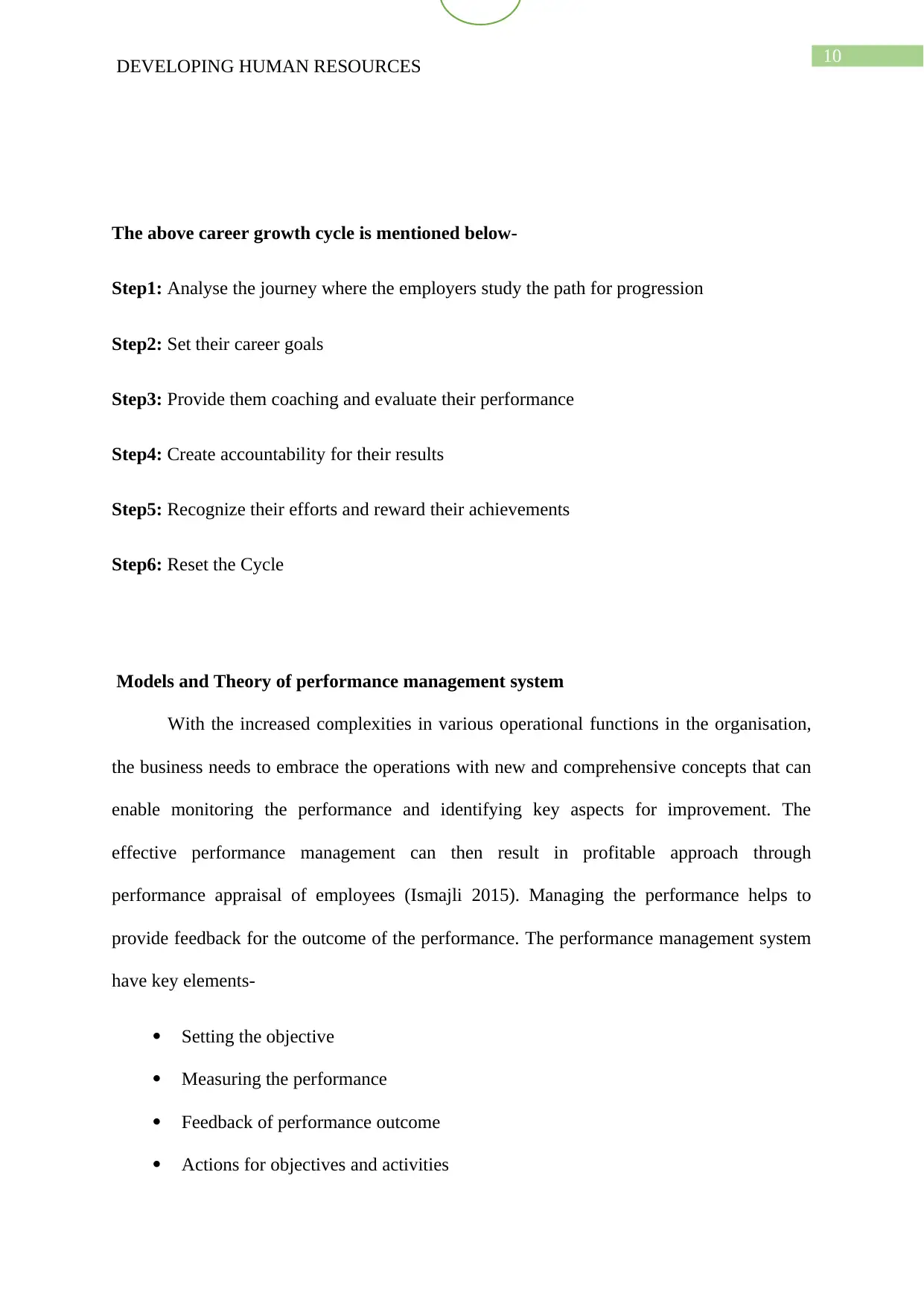
10
DEVELOPING HUMAN RESOURCES
The above career growth cycle is mentioned below-
Step1: Analyse the journey where the employers study the path for progression
Step2: Set their career goals
Step3: Provide them coaching and evaluate their performance
Step4: Create accountability for their results
Step5: Recognize their efforts and reward their achievements
Step6: Reset the Cycle
Models and Theory of performance management system
With the increased complexities in various operational functions in the organisation,
the business needs to embrace the operations with new and comprehensive concepts that can
enable monitoring the performance and identifying key aspects for improvement. The
effective performance management can then result in profitable approach through
performance appraisal of employees (Ismajli 2015). Managing the performance helps to
provide feedback for the outcome of the performance. The performance management system
have key elements-
Setting the objective
Measuring the performance
Feedback of performance outcome
Actions for objectives and activities
DEVELOPING HUMAN RESOURCES
The above career growth cycle is mentioned below-
Step1: Analyse the journey where the employers study the path for progression
Step2: Set their career goals
Step3: Provide them coaching and evaluate their performance
Step4: Create accountability for their results
Step5: Recognize their efforts and reward their achievements
Step6: Reset the Cycle
Models and Theory of performance management system
With the increased complexities in various operational functions in the organisation,
the business needs to embrace the operations with new and comprehensive concepts that can
enable monitoring the performance and identifying key aspects for improvement. The
effective performance management can then result in profitable approach through
performance appraisal of employees (Ismajli 2015). Managing the performance helps to
provide feedback for the outcome of the performance. The performance management system
have key elements-
Setting the objective
Measuring the performance
Feedback of performance outcome
Actions for objectives and activities
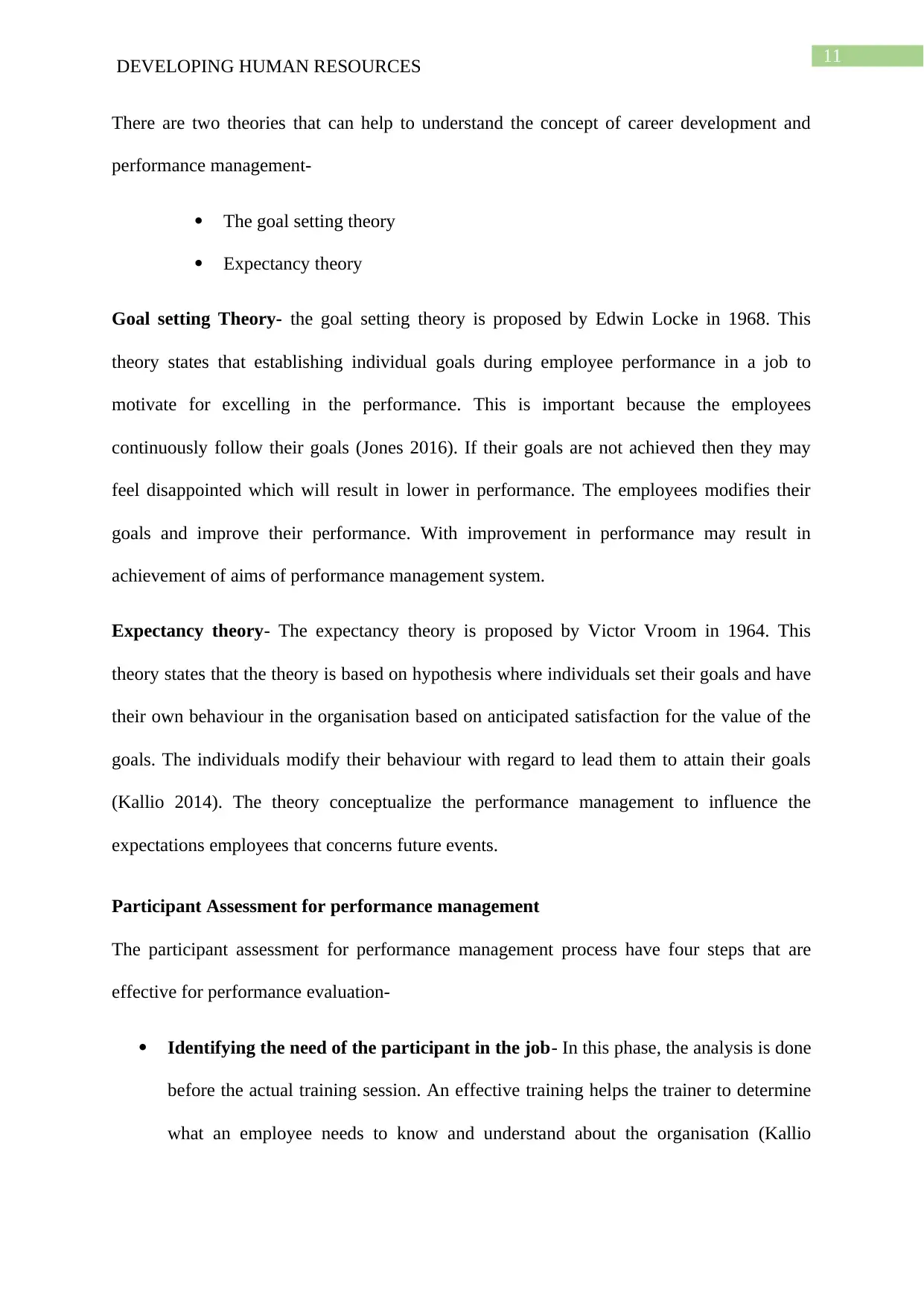
11
DEVELOPING HUMAN RESOURCES
There are two theories that can help to understand the concept of career development and
performance management-
The goal setting theory
Expectancy theory
Goal setting Theory- the goal setting theory is proposed by Edwin Locke in 1968. This
theory states that establishing individual goals during employee performance in a job to
motivate for excelling in the performance. This is important because the employees
continuously follow their goals (Jones 2016). If their goals are not achieved then they may
feel disappointed which will result in lower in performance. The employees modifies their
goals and improve their performance. With improvement in performance may result in
achievement of aims of performance management system.
Expectancy theory- The expectancy theory is proposed by Victor Vroom in 1964. This
theory states that the theory is based on hypothesis where individuals set their goals and have
their own behaviour in the organisation based on anticipated satisfaction for the value of the
goals. The individuals modify their behaviour with regard to lead them to attain their goals
(Kallio 2014). The theory conceptualize the performance management to influence the
expectations employees that concerns future events.
Participant Assessment for performance management
The participant assessment for performance management process have four steps that are
effective for performance evaluation-
Identifying the need of the participant in the job- In this phase, the analysis is done
before the actual training session. An effective training helps the trainer to determine
what an employee needs to know and understand about the organisation (Kallio
DEVELOPING HUMAN RESOURCES
There are two theories that can help to understand the concept of career development and
performance management-
The goal setting theory
Expectancy theory
Goal setting Theory- the goal setting theory is proposed by Edwin Locke in 1968. This
theory states that establishing individual goals during employee performance in a job to
motivate for excelling in the performance. This is important because the employees
continuously follow their goals (Jones 2016). If their goals are not achieved then they may
feel disappointed which will result in lower in performance. The employees modifies their
goals and improve their performance. With improvement in performance may result in
achievement of aims of performance management system.
Expectancy theory- The expectancy theory is proposed by Victor Vroom in 1964. This
theory states that the theory is based on hypothesis where individuals set their goals and have
their own behaviour in the organisation based on anticipated satisfaction for the value of the
goals. The individuals modify their behaviour with regard to lead them to attain their goals
(Kallio 2014). The theory conceptualize the performance management to influence the
expectations employees that concerns future events.
Participant Assessment for performance management
The participant assessment for performance management process have four steps that are
effective for performance evaluation-
Identifying the need of the participant in the job- In this phase, the analysis is done
before the actual training session. An effective training helps the trainer to determine
what an employee needs to know and understand about the organisation (Kallio
⊘ This is a preview!⊘
Do you want full access?
Subscribe today to unlock all pages.

Trusted by 1+ million students worldwide
1 out of 21
Related Documents
Your All-in-One AI-Powered Toolkit for Academic Success.
+13062052269
info@desklib.com
Available 24*7 on WhatsApp / Email
![[object Object]](/_next/static/media/star-bottom.7253800d.svg)
Unlock your academic potential
Copyright © 2020–2025 A2Z Services. All Rights Reserved. Developed and managed by ZUCOL.





